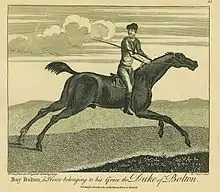Charles Powlett, 3rd Duke of Bolton
Charles Powlett (sometimes spelled Paulet), 3rd Duke of Bolton KG PC (3 September 1685 – 26 August 1754), styled Earl of Wiltshire from 1685 until 1699, and Marquess of Winchester from 1699 until 1722, was a British Whig politician who sat in the English House of Commons from 1705 to 1708 and in the British House of Commons between 1708 and 1717 when he was raised to the peerage as Lord Powlett and sat in the House of Lords..
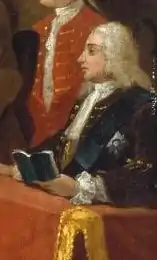
The Duke of Bolton | |
|---|---|
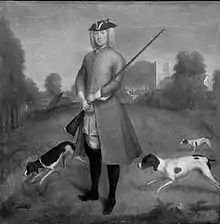 Portrait by James Seymour of the 3rd Duke of Bolton and 8th Marquis of Winchester. Probably in Kingsclere.
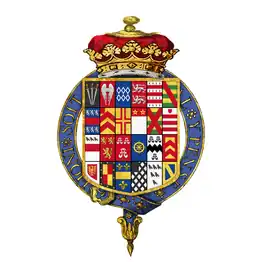 Coat of arms of Charles Powlett, 3rd Duke of Bolton, KG, PC | |
| Personal details | |
| Born | 3 September 1685 |
| Died | 26 August 1754 (aged 68) |
| Spouse(s) | Lady Anne Vaughan (m. 1713, d. 1751) Lavinia Fenton (m. 1751) |
Early life
Powlett was born in 1685 at Chawton, the eldest son of Charles Paulet, 2nd Duke of Bolton, and his second wife Frances Ramsden, daughter of William Ramsden of Byram, Yorkshire.[1] He was educated at Enfield School although his father had to remove him in 1699 for absenteeism and unruly behavior. He travelled abroad with Anthony Ashley from 1700 to 1704. In 1705 he was a volunteer in the Portuguese campaign.[2]
Political career
Powlett was home in time to stand as Whig at a by-election for Lymington on 7 December 1705. He was returned as MP for Lymington. In 1708, he was elected MP for Hampshire in a close contest. However the church interest supported the Tories following the Sacheverell trial and he was defeated there in 1710 and 1713. In 1714 he was appointed Gentleman of the bedchamber to the Prince of Wales.[2]
At the 1715 general election, Powlett was returned as MP for Carmarthenshire. Also in 1715 he was appointed Governor of Milford Haven and Vice-Admiral of South Wales. He was also appointed Lord Lieutenant of Carmarthenshire and Glamorgan. He was created Lord Powlett of Basing on 12 April 1717 and had to give up his seat in the House of Commons. He became Colonel of the Royal Horse Guards in 1717.
In 1722 he succeeded to his father's estates and to the Dukedom of Bolton. He became one of the largest landowners in Hampshire and had control of some parliamentary seats. Therefore, he became one of the principal electoral managers for the Whig government. He was appointed High Steward of Winchester, Warden of the New Forest and Lord Lieutenant of Hampshire and Dorset in the same year. He became a Privy Councillor on 1 June 1725 and was Lord Justice for the year 1725 to 1726. In 1726 he was appointed Commissioner for surveying lands for naval docks and Governor of the Isle of Wight.[3] In 1733 Powlett voted against the government and was dismissed from all his posts.[3] In 1739, he became a founding governor of the Foundling Hospital in London, an orphanage for abandoned children. He became captain of the gentlemen pensioners in 1740. He was reconciled to Walpole and in 1742 was re-appointed to nearly all his previous posts. However he lost them all again in 1746.[3]
Family
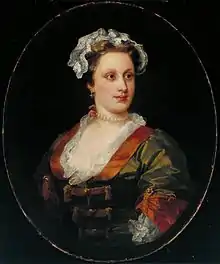
On 21 July 1713, he married Lady Anne Vaughan, a daughter of the 3rd Earl of Carbery. The marriage was not a happy one, and there were no children. In 1728, he began a long-standing affair with the English actress, Lavinia Fenton. Lady Anne died in 1751 and the Duke married Lavinia Fenton on 20 October 1751 at Aix-en-Provence. She had already borne him three illegitimate sons: Charles, Percy, and Horatio Armand Powlett.
The third Duke of Bolton died in 1754, aged 68, at Royal Tunbridge Wells and was buried at Basing.
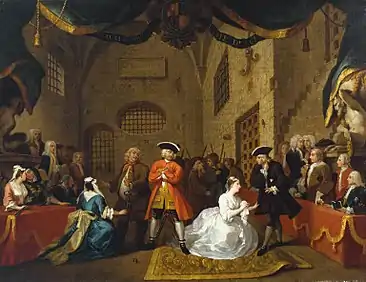
See also
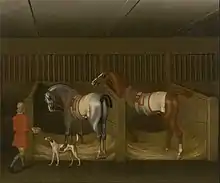
References
- The Oxford Dictionary of National Biography, vol. 45, p.155. Oxford University Press, 2004
- "POWLETT, Charles II, Marquess of Winchester (1685-1754), of Hackwood, nr. Basingstoke, Hants". History of Parliament Online (1690-1715). Retrieved 3 October 2018.
- "POWLETT, Charles, Mq. of Winchester (1685-1754)". History of Parliament Online (1715-1754). Retrieved 3 October 2018.
